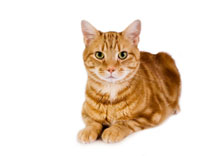Hyperesthesia in Cats

Feline hyperesthesia syndrome and feline psycogenic alopecia are two interesting and often overlapping syndromes of cats. The names are quite a mouthful.
Hyperesthesia means “abnormally increased sensitivity of the skin.” It may begin with signs typical of feline psychogenic alopecia and then escalate. It is known by many names including “rolling skin syndrome,” “twitchy cat disease,” “neuritis,” and “atypical neurodermatitis.”
Signs of Hyperesthesia in Cats
Cats with this syndrome are extremely sensitive when touched along the spine, down the back, and to the base of the tail. The clinical signs seen can include:
- Rippling of the skin over the back.
- Muscle spasms and twitching.
- Twitching of the tail.
- Strange behaviors in response to being touched, such as tail chasing, biting at the tail, flank and sides, running, jumping, vocalizing, and hissing.
- Self-mutilatation with extreme biting, licking, chewing, and plucking of the hair (sometimes called “barbering” or “fur mowing”). This behavior leads to hair loss and sometimes to severe skin lesions.
It is difficult to distract the cat from these behaviors once they begin. The sequence of events varies. Your cat might twitch first, then focus on that spot to lick and chew, or he might be grooming, then start to twitch, then progress to other signs mentioned above. Behaviors that might mimic feline hyperesthesia syndrome are estrus (cats in heat) and certain types of seizure disorders.
The “hyper” behaviors may be provoked by petting or stroking your cat. Hyperesthesia is often found in highly aroused, anxious, or aggressive cats. The exact cause is unknown, however stressful events in your cat’s life may provoke it by causing severe anxiety. It is thought that changes in brain chemicals occur during chronic anxiety and that this can lead to the hyperesthesia disorder.
Stressors That Can Trigger Anxiety in Cats Include:
- Moving to a new home.
- Change in your schedule.
- Addition or subtraction of a human or animal companion in the home.
- Aggression among cats in the household.
- Furniture being moved around.
- Seeing a new animal outside.
- Home remodeling.
- Boredom and frustration.
- Underlying pain may also play a part in this syndrome.
Ongoing anxiety is thought to cause alteration of brain chemicals, so hyperesthesia may then continue on independent of the original underlying condition that triggered it.
Diagnosis of Feline Hyperesthesia
There is no diagnostic test for feline hyperesthesia syndrome, and as with psychogenic alopecia, it is diagnosed by eliminating other diseases from consideration, such as:
- Diseases of the skin (allergies, external parasites, and skin infections, among others).
- Underlying painful conditions such as back pain, arthritis, anal sac disease, muscle pain, spinal disease, bite wounds, abscesses, cancer, or organ problems.
As you can see, the list of possibilities is very long, so your veterinarian must do a thorough physical examination and a variety of diagnostic tests including skin tests, blood tests, viral tests, biopsies, x-rays, and perhaps others. Videos of your cat’s behavior may be helpful. Sometimes, referral to a veterinary specialist such as a dermatologist or neurologist is necessary. When all underlying medical diseases have been eliminated or properly treated, feline hyperesthesia syndrome is diagnosed by exclusion.
Treatment of Hyperesthesia in Cats
Feline hyperesthesia syndrome is treated by decreasing stress in your cat’s life. Try behavior modification, increasing playtime with your cat, and decreasing his boredom by enriching his environment with stimulating activities. Some examples are:
- Hide dry food treats around the house so your cat has to hunt for them.
- Teach your cat to do simple tricks for a food reward.
- Give your kitty lots of attention, and play with him for at least 10 minutes daily.
- Supply your cat with escape routes, such as perches, cubbies, and hiding tents if he is the victim of aggression by other cats in the household, or separate the cats.
- Do not punish this behavior because that might increase your cat's anxiety and worsen his compulsive behavior syndrome.
- Schedule frequent recheck examinations with your veterinarian. An underlying medical condition may become more evident over time.
Sometimes anti-anxiety or anti-depressant medications, such as medications that increase serotonin (a brain chemical), may be helpful and will be prescribed by your veterinarian. These drugs are usually given for about 12 weeks, or until the symptoms decrease, then the dose is slowly tapered. Some cats may not be able to taper off the drugs and will require them indefinitely. Your veterinarian will monitor this condition with blood tests during this treatment period. Many of these drugs are not approved for this syndrome in cats, so your permission is required. Your veterinarian may also refer your cat to a behavior specialist for additional treatment of this unusual syndrome.
You May Also Like These Articles:
Interactive Playing with Wand Toys
How to Keep Playtime Fun for Your Cat





